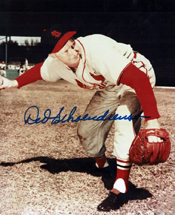There are many frustrating ways to lose a baseball game but perhaps none more so than this:
 Seventy years ago, on Aug. 20, 1954, the Cardinals turned six double plays, tying a National League record, and still were beaten, 3-2, at home against the Reds.
Seventy years ago, on Aug. 20, 1954, the Cardinals turned six double plays, tying a National League record, and still were beaten, 3-2, at home against the Reds.
Though they totaled 12 hits and eight walks, putting a runner on base in every inning, the Reds didn’t do much damage. They had two triples and a double, but none produced a run. The Reds scored one run on a double play and another on a wild pitch.
Meanwhile, the Cardinals ran into outs. They had four runners thrown out on the base paths, including two at home plate. The game ended when a Cardinals runner was nailed trying to score from second on a single.
Twists and turns
The Friday night game featured starting pitchers Joe Nuxhall, on his way to his first winning season with the Reds, against winless Cardinals rookie Ralph Beard, a Cincinnati native.
The first inning set the tone. For the Reds, Ted Kluszewski’s single scored Roy McMillan from second but Jim Greengrass ended the threat by grounding into a double play. For the Cardinals, Wally Moon was thrown out at second attempting to steal.
In the second, the Cardinals nearly turned a triple play. After Johnny Temple and Wally Post opened with singles, Hobie Landrith lined to second baseman Red Schoendienst. He tossed to shortstop Alex Grammas, who made the out on Temple at second, but Post beat Grammas’ peg to first “by a whisker,” the Dayton Daily News reported.
(Schoendienst started four of the double plays; Grammas started the other two.)
The Cardinals made another out on the base paths in the bottom half of the inning. With Rip Repulski on third and one out, Nuxhall snared Joe Cunningham’s grounder and then trapped Repulski, who had broken for home, in a rundown before tagging him out.
More buffoonery in the third: With two outs, Beard uncorked a wild pitch, enabling Bobby Adams to score and extending the Reds’ lead to 2-0.
The Reds scored the decisive run in the fourth. With runners on the corners, none out, Nuxhall rolled into a 4-6-3 double play, but Post came home from third, making the score 3-0.
St. Louis turned its fourth double play in the fifth on Gus Bell’s grounder.
Hits, runs, errors
The Cardinals scored twice in the sixth. With two outs, Stan Musial was on second and Ray Jablonski on first, when Bill Sarni singled to center. Musial scored, and when center fielder Gus Bell let the ball roll between his legs for an error, Jablonski streaked home from first with the second run. Sarni kept running, too, trying to take third, but left fielder Jim Greengrass, who retrieved the ball, fired to third baseman Bobby Adams in time to tag the runner, ending the inning.
The Reds got leadoff triples from Temple in the sixth and Post in the eighth, but failed to score. Kluszewski grounded into double plays in the seventh and ninth.
With two outs and none on in the St. Louis eighth, Reds manager Birdie Tebbetts used a four-man outfield, removing the shortstop, against Musial for the second time that season. Tebbetts wanted to prevent Musial from getting an extra-base hit that would put him in scoring position.
When Musial saw the defensive alignment, he called time and met with Cardinals manager Eddie Stanky. “I told Stan to get on base any way he could,” Stanky said to the St. Louis Post-Dispatch.
Attempting to hit the ball into the vacated shortstop spot for a single, Musial instead grounded out to third, ending the inning.
Hit and run
Clinging to the 3-2 lead, Nuxhall walked the leadoff batter, Ray Jablonski, in the ninth. Dick Schofield, 19, ran for Jablonski and advanced to second on Rip Repulski’s sacrifice bunt. Frank Smith, who threw sidearm, relieved Nuxhall.
Bill Sarni bounced out to Smith, with Schofield holding second. Then Joe Cunningham drilled a low line single to right. Wally Post charged the ball, gloved it and threw a strike to catcher Andy Seminick, nailing Schofield easily for the final out. Boxscore
(Note: The box score, which shows Schofield was on third when Cunningham singled, is wrong. Multiple newspaper accounts of the game report that Schofield was on second when Cunningham got his hit. None report him being on third.)
Asked about third-base coach Johnny Riddle’s decision to wave Schofield to the plate, Stanky said to the Post-Dispatch, “If he hadn’t sent the kid with two outs, I’d have shot him.”
The dramatic finish almost overshadowed the six double plays. It was the seventh time a National League team turned that many double plays in a game, and the third time the team achieving that fielding feat lost, The Cincinnati Post reported.
The Yankees of the American League established the big-league record by turning seven double plays in a win versus the Athletics on Aug. 14, 1942. Boxscore
Since then, the Astros equaled the Yankees’ mark, turning seven double plays in a 3-1 victory against the Giants at the Astrodome on May 4, 1969. Boxscore